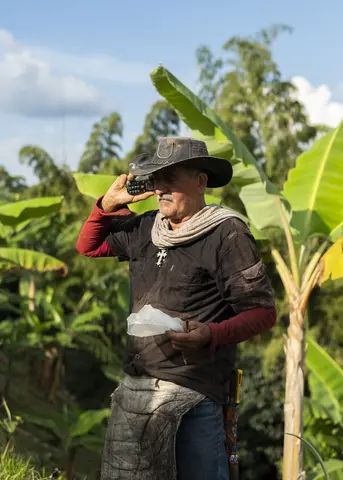I woke up at 5:40am in Chinchiná, what a local coffee roaster here calls the “coffee emporium of Colombia.” Being an industrial town dependent on the cultivation of one of the world’s most important commodities, the days start early. The sun was just breaking through the electric blue morning haze as I walked the two blocks from my hotel to the town’s central market, Galerias. On both sides of the street facing the market at least two dozen colorful repurposed military jeeps idled in front. I noticed that each jeep had a plaque marking a route and destination outside of town. These jeeps, known as Willys, are the main form of transportation for the hundreds of coffee farm workers who work on coffee plantations large and small surrounding Chinchiná. My destination was the bucolic hamlet of La Estrella, where a Colombian friend of mine named Diego recently purchased a coffee farm.
I quickly noticed that most of the farm workers, whether sitting patiently in the back of Willys or grabbing a quick bite to eat at a nearby cafeteria, were older men. There were few women, and the youngest of the men were more often than not the Willy drivers. Why was this? I hadn’t initially come to this industrialized coffee region to answer this question. What had brought me here was my country's emerging fixation on biodiversity and climate change, as well as the environmental impacts of our dependence on commodities like coffee. I wanted to know how the Colombian coffee industry was promoting biodiversity and addressing climate change. Admittedly, I hadn’t given too much thought to who spent their lives picking coffee cherries and maintaining the plantations across Colombia.

But the more time I spent on coffee plantations, particularly the smallholder operations like that of my friend Diego, the more the issue of the age of the labor force came up. Speaking to individuals in the industry, and confirmed by my own research, I found out that the average age of coffee farm workers was 55 years. Many have spent their whole lives doing the physical labor of farm work, and their strong and sinewy bodies attest to that. But these workers are also part of an informal labor system that restricts them to salaries barely at the national minimum wage. Most don’t have social security or access to quality healthcare. And because workers move often from one plantation to another, and from one coffee region to the next, it is difficult for them to build relationships with labor organizations that can represent their interests.
When I arrived mid-morning at Diego’s plantation in La Estrella, the sun was already prickling my skin. Out on the precariously sloped rows of coffee plants, I met Anibal, Diego's sole farm worker. Anibal was 67 years old, dressed in a button-down shirt and a wide-brimmed sombrero. He wore a large cross around his neck. At his waist, an embroidered machete was holstered. I followed him as he cut back plantain trees and pulled up long strands of weeds choking the budding coffee plants. Anibal was contracted to work on Diego’s plantation for four months, and by the time I met him he had two weeks left. I asked him if he had a family. “No los veo mucho” [I don’t see them much], he said. His children had left rural life behind and gone to live in Medellin, Colombia’s second largest city. Like many other youth in the coffee region, they studied, found passions elsewhere, or merely idled. If older coffee farm workers like Anibal had any illusion that their children and grandchildren would take up the mantle of a life of physical labor and economic hardship, it seemed increasingly that they were mistaken.
In exploring the question of why so many of the coffee farm workers were older men, an even bigger, existential question inevitably came up: Who would replace this labor force once they were gone?











